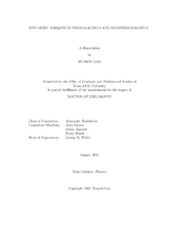| dc.description.abstract | Spintronics is a sub-field of condensed matter physics which explores the physics of electrons involving both their charge and spin, with an emphasis on the active manipulation of the spin degree of freedom in solid state systems. In spin-based memory and storage devices, information ( 0 or 1) is stored based on the magnetization orientation in ferromagnets or layered magnetic structures. We study the utilization of spin-orbit torques in ferromagnets and antiferromagnets as an effective ways of magnetization switching in these nonvolatile memory devices. The method we use is linear response theory and numerical simulation. Our results show that the spin-orbit torques are effective approaches of manipulating magnetization in both ferromagnets and antiferromagnets, which can be used in the future memory device applications.
In ferromagnets, we start from a simple two dimensional electron gas ferromagnetic model with Rashba spin-orbit coupling to study the different components of spin-orbit torques and the parameter dependence. The results show the existence of these torques. Then, we study these torques in a realistic material, GaMnAs, with a complex band structure. We confirm that these torques have the same parameter dependence in GaMnAs and the simple two dimensional model. The complex band structure changes the magnitudes of the effective fields and shows more features in the results which unveils the competition between band structure and spin-orbit coupling.
In antiferromagnets, by studying the spin-orbit torques in the two dimensional antiferromagneic model and the realistic material Mn2Au, we predict that a lateral electric current in antiferromagnets can induce non-equilibrium Neel-order fields, i.e., fields whose sign alternates between the spin sub lattices, which can trigger ultrafast spin-axis reorientation. Due to the two dimensional nature, the spin-orbit torques can have large magnitudes if we tune the Fermi energy to a certain level. We then extend the study to the three dimensional non-collinear antiferromagnet IrMn3. | en |


